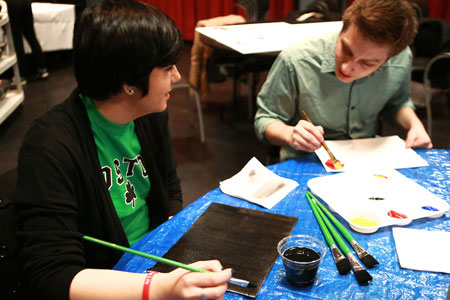
by Abby Ledoux ’14
Emerson’s Aim to End Violence Week launched March 25 with an event called “Painting Your Pain,” which had students using art to express their feelings on gun violence.
The weeklong series of events is meant to encourage a campus dialogue on America’s culture of gun violence. Several student organizations are co-sponsoring the week, which is spearheaded by Emerson Peace and Social Justice.
“This event is a mix of conversation and creativity,” Dennis Connors ’15, an Emerson Peace and Social Justice member, said of Painting Your Pain. “We wanted to have different event types.”
As music played throughout the Piano Row Multipurpose Room, students gathered around tables and painted everything from peace signs to rifles to abstract motifs.
“I think this event is really important because it’s just about creating art, which is a lot of what our school is about,” said Victoria Masteller ’16. “It’s an easy technique that creates conversation.”
"Before, we were talking about inner-city violence,” said Connors. “So we’re painting what is inspired by that conversation to express ourselves.” A large poster on a nearby table asked students, “What does gun violence mean to you?” In different colors they scrawled their answers, ranging from “preventable losses,” “a solvable issue,” “lack of control,” to “something I see on TV.”
“I’ve been very supportive of everything Emerson Peace and Social Justice has done this whole week,” said Nick de la Canal ’15, who attended the event. “I think it’s good to bring awareness to gun violence.”
De la Canal is also president of the Class of 2015, which organized a candlelight vigil for victims of gun violence that took place on Boston Common on the night of March 25.
“The biggest inspiration for us was [Emerson President Lee] Pelton’s letter to the school, and his letter to President Obama,” Connors said. “We saw that as a call to action, and that something needed to happen within the school community, student-run, to start to have that dialogue.”
Shortly after the December school shooting massacre in Newtown, Connecticut, Pelton gathered nearly 300 signatures from college and university presidents pledging to join him in increasing dialogue on gun violence on campuses across the country. The signatures were attached to a letter sent to President Obama. Pelton also started the College Presidents’ Gun Violence Resource Center website.
Aim to End Violence Week will continue through March 30, when the week concludes with a letter-writing initiative for students to express their opinions on gun control to congressional representatives.
“Where does violence come from? What can we do to help bring about its end? What are the controversial issues that we can talk about?” Connors said. “That’s how we got this started.”
This article can be found on the Emerson website here.
Emerson’s Aim to End Violence Week launched March 25 with an event called “Painting Your Pain,” which had students using art to express their feelings on gun violence.
The weeklong series of events is meant to encourage a campus dialogue on America’s culture of gun violence. Several student organizations are co-sponsoring the week, which is spearheaded by Emerson Peace and Social Justice.
“This event is a mix of conversation and creativity,” Dennis Connors ’15, an Emerson Peace and Social Justice member, said of Painting Your Pain. “We wanted to have different event types.”
As music played throughout the Piano Row Multipurpose Room, students gathered around tables and painted everything from peace signs to rifles to abstract motifs.
“I think this event is really important because it’s just about creating art, which is a lot of what our school is about,” said Victoria Masteller ’16. “It’s an easy technique that creates conversation.”
"Before, we were talking about inner-city violence,” said Connors. “So we’re painting what is inspired by that conversation to express ourselves.” A large poster on a nearby table asked students, “What does gun violence mean to you?” In different colors they scrawled their answers, ranging from “preventable losses,” “a solvable issue,” “lack of control,” to “something I see on TV.”
“I’ve been very supportive of everything Emerson Peace and Social Justice has done this whole week,” said Nick de la Canal ’15, who attended the event. “I think it’s good to bring awareness to gun violence.”
De la Canal is also president of the Class of 2015, which organized a candlelight vigil for victims of gun violence that took place on Boston Common on the night of March 25.
“The biggest inspiration for us was [Emerson President Lee] Pelton’s letter to the school, and his letter to President Obama,” Connors said. “We saw that as a call to action, and that something needed to happen within the school community, student-run, to start to have that dialogue.”
Shortly after the December school shooting massacre in Newtown, Connecticut, Pelton gathered nearly 300 signatures from college and university presidents pledging to join him in increasing dialogue on gun violence on campuses across the country. The signatures were attached to a letter sent to President Obama. Pelton also started the College Presidents’ Gun Violence Resource Center website.
Aim to End Violence Week will continue through March 30, when the week concludes with a letter-writing initiative for students to express their opinions on gun control to congressional representatives.
“Where does violence come from? What can we do to help bring about its end? What are the controversial issues that we can talk about?” Connors said. “That’s how we got this started.”
This article can be found on the Emerson website here.
 RSS Feed
RSS Feed